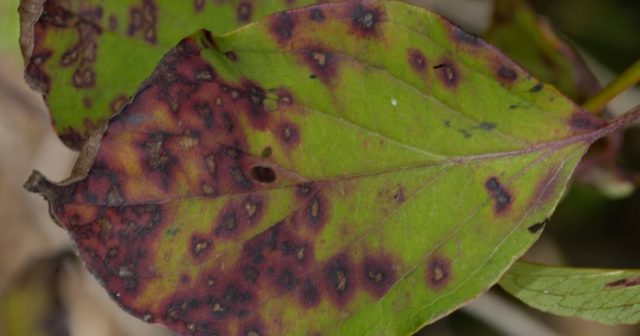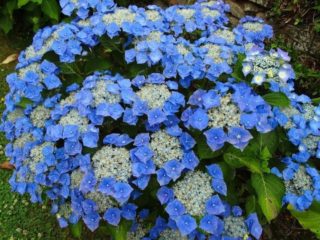Content
This plant is a real decoration for any garden. The most decorative are the paniculate species, in particular the Kyushu hydrangea. Beautiful, lush shrubs “came” to Europe from Japan and won the hearts of millions of gardeners.

Hydrangea Kyushu - decoration of any garden plot
Description of hydrangea Kyushu
Hydrangea Kyushu is a deciduous plant. Its height reaches 2.5-3 m. The plant is unpretentious to the composition of the soil, but does not tolerate clean sandy environments and does not grow in swampy areas. Even without flowering, the bushes are highly decorative due to the unusual combination of upright brown shoots with oval leaves of a rich emerald color with red petioles.
Another distinctive feature of the Kyushu hydrangea is its lush crown, which can reach 3 m in diameter.Beginning in June, cone-shaped inflorescences form. At first, the color of the petals is white, but closer to autumn they acquire a pinkish tint. Thanks to pruning, the bush can be given almost any shape.

The bush can grow up to 3 m high
Hydrangea Kyushu in landscape design
Hydrangea paniculata Kyushu is a born diva. It has beautiful white flowers that create a mesmerizing picture: the delicate petals seem airy and weightless, as if straight from the pages of a fairy tale. Benches and swings are often placed near these bushes so that during the flowering period you can admire this pure beauty and take a break from everyday worries.
Even one single bush planted in the center of the site will definitely attract everyone's attention. Additionally, the planting site can be decorated with decorative stones or paved around a path with tiles of unusual shape.
Often the garden needs zoning. This allows for more efficient use of the territory and orderly planting. Designers often use Kyushu hydrangea as a hedge. It is also appropriate in group plantings, near artificial ponds, gazebos and benches.

Openwork inflorescences of Kyushu hydrangea create a soft and cozy atmosphere in the garden
Winter hardiness of hydrangea Kyushu
Hydrangea Kyushu is characterized by high winter hardiness. Sensitivity to low temperatures is characteristic only of young plants. With age, they become hardened and easily endure the winter.
Planting and caring for Hydrangea paniculata Kyushu
The most optimal time for planting Kyushu hydrangea is spring. It is necessary to wait until the snow cover has completely melted and the soil has warmed up.If we are talking about the southern regions, then it is permissible to start planting Kyushu hydrangea in the fall, no later than mid-September. It is important that the seedling has a well-formed root system. Young bushes with weak roots are planted only in the summer so that they have time to fully grow stronger.
Selection and preparation of a landing site
For normal growth and development of Kyushu hydrangea, a well-lit place is required, but without contact with direct sunlight. Otherwise, the shoots will lose their decorative effect, and the soil will dry out too quickly. However, complete shade is also not suitable.
The golden mean will be an area where there will be a sufficient amount of soft, diffused light for most of the day. It is also worth considering the proximity of trees and other shrubs. They should not greatly shade the hydrangea or take away moisture and nutrients from it.
The area must be completely cleared of weeds, the soil must be dug up and leveled. A few days before the planned planting of the Kyushu hydrangea, you can begin to prepare the hole. Its width is 55-60 cm, and its height is 40 cm. It takes a little time for the soil to completely subside. Drainage in the form of expanded clay, crushed brick or crushed stone is poured onto the bottom of the pit (layer height no more than 8 cm).
Next come several types of fertilizers (nitrogen, potassium, and superphosphate). Nitrogen is especially important in the spring, as it actively stimulates vegetation.In the fall, it is practically not used, because the young branches that have grown back will not withstand the upcoming cold weather. After fertilization, peat is poured (to obtain optimal soil acidity) and humus. It is prohibited to use lime or fresh manure, otherwise the root system will die. All components must sit in the pit to allow them to shrink. It is best to choose a dry week so that the planting hole does not become flooded with water.
Landing rules
The seedling is immersed in the “settled” planting hole. Before transplanting Kyushu hydrangea shoots, the roots are shortened slightly to stimulate their further growth. During spring planting, the shoots of Kyushu hydrangea are also pruned, leaving only 3-4 buds. The seedling is slightly buried, and the root collar is sprinkled with a small layer of soil (just a couple of cm). After watering, it will lower and the neck will be above the soil level. Afterwards, the tree trunk circles are mulched. To do this, use any available materials: dry sawdust, nut husks, straw or pine needles.

Hydrangea Kyushu is best planted in spring
Watering and fertilizing
Hydrangea Kyushu on a trunk needs moisture, so it needs regular watering as the soil dries out. It is best to moisten the soil in the morning to protect the bush from burns and prevent rapid evaporation of water. Drought is contraindicated for Kyushu hydrangea; it tolerates a slight stagnation of moisture more easily than its complete absence.
No less important for Kyushu hydrangea are feeding. Apply 4 times per season:
- The first occurs at the very beginning of spring, when active sap flow begins. During this period, organic matter is introduced (solutions based on manure or bird droppings).
- The second is during the formation of buds.To do this, use a mixture of superphosphate with urea and potassium sulfate, diluted with water.
- The third feeding is applied in mid-summer. Complex mineral fertilizers in granules give good results.
- The Kyushu hydrangea is fed for the fourth time before winter, using special nitrogen-free preparations.
Pruning Kyushu hydrangea
A lush bush without proper care will quickly lose its shape. However, pruning Kyushu hydrangea, in addition to its aesthetic function, has an overall beneficial effect on the plant. If you prune the hydrangea before the buds begin to open, in the future it will delight you with generous and long flowering. Without this procedure, flowers may not appear at all.
At the end of autumn, all inflorescences of the Kyushu hydrangea are cut off, as well as weak and rotting shoots. In spring, do the same with frozen branches. To rejuvenate bushes, they resort to radical pruning right down to the stump.
Preparing for winter
Young plants, especially first-year ones, should be carefully insulated. All inflorescences are cut off from the shoots of the Kyushu hydrangea, the stems are bent to the ground and slightly pressed down so that they do not straighten. The branches and part of the soil are covered with special agrofibre or spruce branches on top.
Mature strong bushes do not react to frost. It is enough to simply tie their branches and fix them on a support. This will protect them from breaking off by the wind and sagging under the weight of snow. You can see how to properly prune Kyushu hydrangea in the video:
Reproduction
Hydrangea Kyushu is bred in several ways:
- Seeds. A soil mixture of leaf soil, peat and sand is poured into a convenient container. Planting material is immersed in it and lightly sprinkled with earth. It is moistened from above using a spray bottle.The first shoots of Kyushu hydrangea can be seen on the 45th day. Before this, the soil is regularly moistened. After the sprouts appear, you can remove the film and after a while pick up the plantings into small cups. When 4 strong leaves are formed, they are planted in small pots. Next comes a hardening period so that the plants get used to fresh air. After 2 years, the sprouts are transferred to the garden, immediately choosing a permanent place.
- Cuttings. It is necessary to select healthy branches that have several formed buds. First, they are rooted in a container of water and then transferred to nutritious soil. If the Kyushu hydrangea cutting is planted directly into the ground, its lower leaves are cut off completely, and the upper leaves are cut off by ½ of the length. There must be a transparent dome on top to create a greenhouse effect.
The same care for rooted cuttings as for sprouts obtained from seeds
- By layering. The lower shoot of the Kyushu hydrangea is bent to the ground and sprinkled with a layer of soil, firmly fixing it. The upper part of the branch remains above the ground (it is tied to a support). After the side shoots appear, they are earthed up in several stages. Rooted cuttings are carefully separated and transferred to a previously prepared place.
Diseases and pests of hydrangea paniculata variety Kyushu
Diseases affect Kyushu hydrangea bushes due to improper care, unsuitable soil composition and sudden temperature changes. Common problems include:
- Chlorosis. Occurs due to iron deficiency. The veins of the sheets begin to noticeably lighten. Iron sulfate or citric acid will help correct the situation.
With chlorosis, leaf veins lighten
- Gray rot. Ulcers and characteristic dark spots form on the leaf blade.Spray with a soap solution containing copper.
This infection spreads quickly, so it is important to get rid of the affected parts of the plant in a timely manner.
- Septoria. It is expressed in brown spots, after a while the crown begins to actively crumble.
Bordeaux mixture fights the problem well
Among the most dangerous pests of Kyushu hydrangea are aphids, spider mites and slugs. To combat them, gardeners use traditional methods or resort to modern effective insecticides, using them strictly according to the instructions.
Conclusion
Hydrangea Kyushu is an unpretentious and very beautiful plant that is easy to propagate. By placing several of these bushes on your garden plot, you can properly zone the garden, create cozy places to relax, and complement flower arrangements. Snow-white inflorescences will delight you with their lightness, tenderness and subtle pleasant aroma.












